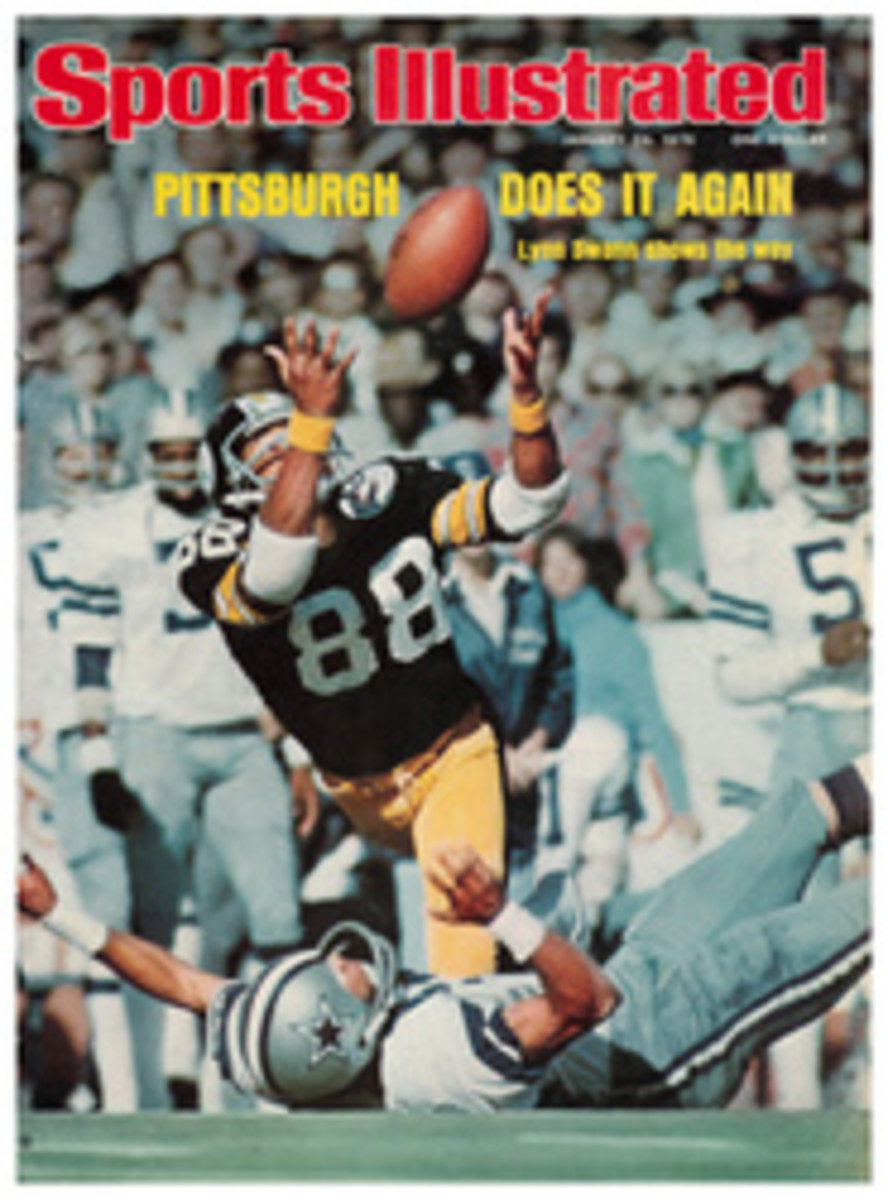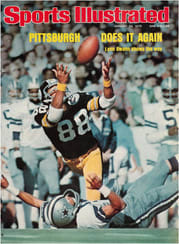
A LONG SHOT RIGHT ON TARGET
Since British police officer Geoff Capes stands 6'6", weighs in the vicinity of 300 pounds and is proficient at judo, one can safely assume that in his home village of Brampton, not far from Cambridge University, would-be troublemakers wisely choose to cross only at the corner. Capes is not only built like a buffalo, but he could probably consume one for dinner and still have room for two helpings of English trifle, so it is a good thing that neither the Cambridge-shire constabulary nor Capes himself is entirely responsible for his grocery bills. A dairy company provides him with three quarts of milk a day and a national chain of butcher shops supplies three pounds of steak daily. The merchants are being patriotic, you see, for Capes, in addition to his duties as a cop, happens to be the best shotputter in the history of the United Kingdom.
It would be far more impressive, admittedly, if Capes were the best seaman or best actor or best rock guitarist, for Great Britain has not been blessed with heavers of the shot and whirlers of the discus. Capes is exceptionally good, however, as U.S. track and field fans first learned two weeks ago at the National Invitational meet in College Park, Md., where he defeated Al Feuerbach. Last Friday night Capes did it again, winning at the Sunkist Invitational in the Los Angeles Sports Arena with a put of 68'10", a new British Commonwealth and European indoor record.
In the 18 modern Olympiads, starting with the Athens Games in 1896, the U.S. has dominated the shotput, winning 15 gold medals (Ralph Rose and Parry O'Brien won two apiece). Finland, Germany and Poland each have won one. Britain, where track and field is called "athletics," has not won a medal since 1908, so Capes is not being falsely modest when he calls himself a dark horse.
"I reckon it's going to be really tough for me to win a gold medal in the Olympics," he said after the L.A. meet. "I think I'm an outsider because, let's face it, a British athlete putting the shot and winning the Olympic Games?...I'm here to remedy that, you know, and to put it right.
"My personal record indoors was 68'9", so 68'10"—at least it's an inch in the right direction, you know. I think, with the next five meetings, it's going to go as well as it's gone today. I'm hoping for longer things, not bigger things.
"My coach said, 'Irrespective of the distance, of how far you throw over there, you just have a good time training.' It's raining in the U.K. It's wet and windy and terrible. I came over here, first, to train and, second, to compete, but it seems to be turning the other way around. It's working well together."
Capes will spend 5½ weeks competing in the U.S., representing the Enfield Club, near London. He trains with an extraordinary group of weightmen who live in and around San Jose—pro Brian Oldfield, who is preparing for the TV Superstars competition; discus thrower John Powell, like Capes, a policeman; Feuerbach, who finished a disappointing fourth in the Sunkist; and Ron Semkiw of San Jose State. Capes' wife and two children stayed home.
The son of a Lincolnshire farmer, Capes, 26, worked on the farm until he was 19, at which point he followed his grandfather, uncle and three older brothers into police work. He walked a beat and worked out of a patrol car for a few years and now is a physical education instructor for other police officers. Normally he prefers to train in seclusion, locked away in a police gymnasium, much in the manner of George Woods, who is skipping the indoor season and will emerge from his Edwardsville, Ill. cocoon in April to compete in outdoor meets leading up to the Montreal Games. Woods probably will be the Olympic favorite, but Capes is not far behind in potential, says his coach, Stuart Storey, once an imported hurdler at Western Kentucky.
The Sunkist was a good showcase not only for Capes but for a lot of other people. The Sports Arena was packed with more than 13,000 fans—a few hundred latecomers were turned away—and if the orange-and-lemon-striped track didn't remind everyone of the sponsor's citrus products, the barrels of oranges sitting in the infield put an exclamation point on the plug. Among the broomstick limbs of the distance runners and the slender legs and muscular torsos of the pole vaulters, the bulky Capes stood out in his gray sweat shirt and dark beard, which he grew in 1970 to keep the shot from irritating his neck. He looked something like a giant Pluto among a throng of Popeyes and Olive Oyls.
Two of the biggest names in U.S. track, Frank Shorter and Marty Liquori, were on hand, and both were beaten. Shorter, running the two-mile, lost to Paul Cummings of the Beverly Hills Striders, Cummings winning easily in a creditable 8:29.6. Liquori, who is pointing toward the 5,000 in Montreal, ran the mile in Los Angeles and finished third behind Tony Waldrop and Danie Malan. Waldrop's time, 4:02, was seven seconds off his world indoor record, but it was his first major indoor victory since his phenomenal 1974 string. In the women's mile Francie Larrieu won, as expected, in 4:37.2.
Dwight Stones took the high jump at 7'2", but pole vaulter Dan Ripley, who had set an indoor record of 18'¼" the week before, could do only 17'6" and finished second to Yuri Isakov of the Soviet Union, who cleared the same height with fewer misses. Valery Borzov, winner of the 100 and 200 meters at Munich four years ago, was also competing on the second leg of a U.S. tour. He looked a bit paunchy and had injured a muscle in his left calf a few nights earlier in Mobile, Ala. where he finished fifth, so the experts thought he had only a flickering candle's chance in a Siberian snowstorm to stay alive against 18-year-old Houston McTear, co-holder of the world record in the 100-yard dash. The experts were right.
In the 50-yard dash McTear, representing the Northwest Florida Track Club, did not seem bothered when his rivals were guilty of four false starts. On try No. 5 he exploded out of the blocks, accelerated like a dragster and easily held the lead to win in 5.1, one-tenth over the world indoor record. Borzov was second in 5.3 and Jamaica's Don Quarrie third in 5.4. Steve Williams, the early favorite in the 100 at Montreal, scratched because of an injured toe.
McTear took the 60 just as easily, beating Quarrie—Borzov scratched—and was voted Athlete of the Meet, but he did not stick around for the presentation of his TV set. Showing a few tricky moves he may use as a college running back, he disappeared from the arena to telephone his father, who had undergone brain surgery two weeks before.
"I think he is going to be the best sprinter in history," said his coach, Will Willoughby. "He came here expecting to win both races, and I thought he would, too. He's right where I want him right now. He's in good shape, but he's not in great shape.
"His dad will never work again and he has seven brothers and sisters. They need financial help and are getting by mostly through me. If he could get a good pro track offer, I'd advise him to take it right now. His family needs the money desperately."
Borzov, through an interpreter, said he was unconcerned about the loss because he is using the indoor season merely for training. "McTear is the best in the short sprints in the United States," he said. "His start is very good, but that is not the most important factor in the 100. Charles Greene, Herb Washington and Mel Pender have very fast starts, too—I would say about as good as his. However, I see no reason why he should not be great at 100 meters."
Next to McTear's 5.1 in the 50, perhaps the most impressive mark in the meet was Rick Wohlhuter's 1:49.2 in the 880, a race in which he handily whipped Kenya's Mike Boit, considered by some the finest 800-meter runner in the world. Wohlhuter, an insurance salesman in Chicago, was the Sullivan Award winner in 1974, when he was undefeated in the 880 and set a world record, but he was definitely beatable last year. One of the reasons, he thinks, is that he fooled around too much with the mile. This year with Montreal in mind, he is going to be almost exclusively an 800-880 man.
Capes has made a similar decision regarding the shot and the discus. In the 1974 Commonwealth trials he threw the discus 191'8", but has not tried it often since. He decided to forget versatility and concentrate his considerable powers on propelling the 16-pound shot farther than any Britisher before him. It should help him a great deal to hang around for a while in San Jose, where there are more 60-foot shotputters courting hernias than in all the British Isles, and maybe all the English-speaking world outside the United States.
One problem for Capes in L.A., besides jet lag, was that the oversize U.S. indoor shot felt like a bowling ball in his paw. It is curious that both the British golf ball and the indoor shot are smaller than the U.S. versions.
"The U.S. shot is about an inch and a half more in diameter," said Capes. "And although I have big hands, I had difficulty in holding it. It took all week to get the feel of the thing. It's very awkward. I've got a very long neck, too, which makes using a bigger shot even more difficult."
But Geoff, wouldn't the bigger ball fill up more space on that long neck and...oh, well, better to leave that discussion to Shotputters' Digest or Paranoia Today. And it is not worth examining the finer points of Capes' rather conventional form. One of his few deviations from the behemoths' norm is that before he starts his skip-and-spin trip across the ring, he is balanced on two legs rather than one, which makes good sense when you remember that his brawny body, nourished by "meat, milk, eggs—all that good stuff," would strain a steel pillar.
After his visit to the U.S., Capes will hurry back for the European Indoor Games in Munich, a stretch at home in Cambridgeshire and then serious solitary training with his coach in the south of France. Many view his chances in Montreal as very good because he is naturally gigantic, whereas a lot of other shotputters have achieved success only after adding bulk with the now illegal and potentially dangerous steroids. And new tests have been developed that detect steroids more accurately.
"The tests will separate the men from the boys," Capes said, "and the genuine athletes from the blown-up athletes."
As a former soccer and basketball player, cross-country runner and gymnast, Britain's brawny bobby is clearly genuine.
PHOTO
GEORGE LONG
Capes' style is conventional and his bulk is genuine, a distinct advantage in his event.
PHOTO
GEORGE LONG
In the 50-yard dash McTear (second left) showed the visiting Borzov (middle) why everyone is talking about him, as he led from start to finish.
PHOTO
GEORGE LONG
Waldrop's mile put him back in the news.
PHOTO
GEORGE LONG
The 880 is Wohlhuter's best distance, and at the Sunkist he beat Kenyan ace Mike Boit (left).

